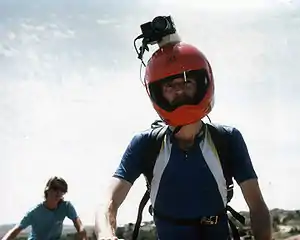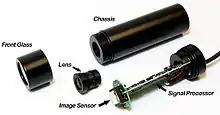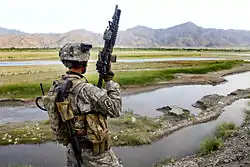Helmet camera
A helmet camera, otherwise known as a micro video camera, is an action camera, usually a closed circuit television camera, attached to a helmet allowing someone to make a visual record from their point of view (POV), while keeping their hands and vision free.
History

Archives containing photos of helmet cameras have surfaced over the last decade. One shows Denver Broncos backup quarterback Jacky Lee wearing a helmet camera at football practice in 1965.[1][2] A mocked-up helmet camera appears in the opening scenes of The Private Afternoons of Pamela Mann, released in 1974, used by a character for voyeurism. Another early and more noble helmet video camera was a 1977 head-mounted camera designed to convert images into tactile sensations for the blind.[3]
Almost a decade later, a Canon CI-10 camera was mounted to the side of Dick Garcia's helmet by Aerial Video Systems (AVS) of Burbank, CA at the Nissan USGP 500 World Championship at Carlsbad Raceway in Carlsbad, CA on June 28, 1986.[4][5] At this time the helmet camera was used commercially. For the first time, images were transmitted live from this camera by AVS via portable microwave to the ABC broadcast truck, then integrated into their live broadcast. This innovative system showed viewers the rider's Point of View of the race as it unfolded.

Another early innovator of video helmet camera technology was Mark Schulze, who created a system for use while producing The Great Mountain Biking Video in 1987.[6][7][8][9] "Schulze stripped-down a red motorcycle helmet and jury-rigged a mounting for the first consumer color video chip camera. A cable ran from the camera to a padded backpack that contained a Panasonic VHS portable video recorder and a DC-lead-acid battery for power, which made the rig heavy, unwieldy, and hot.[10]
This pioneering technology brought an engaging perspective to live sports television and action sports videos and eventually gave way to button and lipstick cameras. The helmet cam then became a standard piece of equipment, worn by umpires, catchers, goalies and referees for live television as well as BMX riders, surfers, skiers, skydivers, hockey and soccer players and other sports aficionados, to record and share their experiences.[11][12][13][14]
In 1991, the World League of American Football introduced the innovation of a miniature camera mounted on the right side of the VSR-3 Riddell helmet worn by quarterbacks. This rig was developed by USA Network and Aerial Video Systems (AVS). An antenna was placed in the crown of the helmet between an inflatable pad and the shell. Each of these Helmet-Cams cost $20,000 and transmitted live game action.[15][16] These helmet cams were briefly used to provide live player's-eye-view footage in professional American football. However, their use was discontinued after players complained of the extra weight, and TV networks became concerned about the aggressive behavior the cameras captured.
In 2002, after graduating with a degree in Visual Arts from UCSD, Nick Woodman, a long-time surfer, created the GoPro camera. This was a small, wearable camera with a waterproof housing for people to share their personal experiences in sports and other endeavors with the world.[17][18]
Today's generation of helmet cameras offer features like on-screen menus, high-definition format, wireless transmitting to an offsite recording device, waterproof enclosures, multiple mounts and 3D capabilities.[19]
Camera types

Helmet cameras generally fall into two main categories; CMOS and CCD type. Although helmet cameras take on a variety of forms, the majority are small cylindrical cameras resembling a tube of lipstick or a bullet. Helmet cameras may be connected to a video recording device with video input capability, such as a handheld camcorder, or purpose built digital video recorder.[20]
CCD helmet cameras are based upon the charge-coupled device (CCD) image sensor. They typically operate on 12 VDC power and output an analog type signal. These cameras draw more power than CMOS cameras but offer superior picture quality and better color replication.
CMOS helmet cameras are based upon the complementary metal–oxide–semiconductor (CMOS) image sensor. They typically operate on 5 VDC and draw very little power. CMOS cameras are also generally smaller than the CCD type.
Applications

.jpg.webp)
Many sports enthusiasts use helmet cameras to capture the essence of the sports they love. For example, many paraglider pilots carry a bullet camera to record their flights. This can be mounted on the helmet, foot or elsewhere to capture unique camera angles. There are many samples of helmet camera videos available on the net.[21]
Wearing helmet cameras is also proving popular with cyclists as a safety aid as it allows cyclists to record their journeys and to record any incidents from their point of view. This recording can be used in a court as evidence.[22]
In 2006, a British cyclist was convicted of abusing traffic wardens, using evidence from a helmet camera.[23]
Also in 2006, in the documentary Race To Dakar, Charley Boorman, Matt Hall and Simon Pavey used helmet cams to document their participation the 2006 Dakar rally. Out of the trio, Pavey was the only member of the "Race To Dakar" team wearing the camera to make it to the Senagalese Capital and (the rally's finish).
In 2011, Ben Maher won the Martin Collins Eraser Stakes at London Olympia horse show while wearing a helmet camera.[24]
Firefighters have begun to utilize helmet cams as a tool to assess their responses to fires and allow non-firefighters to see the reality of what occurs inside a burning building. One technological improvement that fire departments would employ would be thermal imaging detection of differences in heat.[25][26]
Helmet cameras are also being used in the military, where video footage can be streamed back to a command center or military outpost. A notable instance of this was the raid on Osama Bin Laden’s compound, where live video footage of the raid is believed to have been streamed to the White House.[27] In 2013 a British Royal Marine soldier was convicted of murder after shooting to death an unarmed and injured Afghan insurgent, contrary to the Geneva Convention. The incident had been recorded by a helmet camera whose images and sound were used in evidence at a court martial relating to the incident.[28] The helmet camera, has been the focus of the Discovery Channels latest war series Taking Fire about the 101st Airborne in the Korengal documenting their personal war footage.
In 2012, on the occasion of the 50th birthday of RP FLIP ("Floating Instrument Platform"), several GoPro action cameras were placed on various positions aboard the research vessel to capture it as it flipped and descended into the ocean.
In 2016 "a camera recovered from the helmet of a dead fighter offers a contrasting picture of chaos and panic in a battle with Kurdish peshmerga."[29]
See also
References
- The Denver Post, "Broncos wore helmet cameras long before GoPro was born, by Nicki Jhabvala, August 30, 2015 http://blogs.denverpost.com/broncos/2015/08/30/broncos-wore-helmet-cameras-long-before-gopro-was-born/35169/
- Sports Grid "Some Hilarious Historical Shit" by Rick Chandler, August 26th, 2015 http://www.sportsgrid.com/nfl/the-denver-broncos-helmet-cam-circa-1965-is-some-hilarious-historical-shit/
- "A brief history of wearable computing". Retrieved 16 August 2015.
- Glick, Shav (June 28, 1986). "Carlsbad's Last Motocross Grand Prix Is Today : Raceway Where the Sport Developed Has Produced Its Share of Memories". Los Angeles Times.
- "The Pits". Motocross Action. Hi-Torque Publishing Co., Inc.: Page 31 October 1986. Archived from the original on 2010-08-14.
- "Going Hollywood," Mountain & City Biking Magazine, April 1989
- "Archived copy". Archived from the original on 2012-03-20. Retrieved 2011-04-01.CS1 maint: archived copy as title (link)
- http://mountainbiketales.com/articles/patty0610.htm Mountain Bike Tales
- Coldwell, Will (April 12, 2012). "Who dares films: Why extreme-sports fans love helmet-mounted cameras". The Independent. London.
- "Archived copy". Archived from the original on 2012-06-24. Retrieved 2012-07-10.CS1 maint: archived copy as title (link)
- Sports Video Innovations http://www.sportsvideoinnovations.com/
- The Daily Dot "This hockey ref's helmet cam is the future of televised sports" by Michelle Jaworski — Dec 23, 2013 at 2:47PM http://www.dailydot.com/unclick/hockey-ref-helmet-cam-footage/
- Motor Racing, "Helmet cam gives you driver's perspective of a lap at the Nurburgring" By Samuel Reiman, May 20, 2016 at 10:49a ET http://www.foxsports.com/motor/story/video-nurburgring-helmet-camera-052016
- The Salt Lake Tribune, "College football: Helmet cams could give teams a new point of view" By Lya Wodraska The Salt Lake Tribune First Published Aug 16 2015 10:54AM, http://www.sltrib.com/home/2785043-155/college-football-helmet-cams-could-give
- Nancy Gay, The Sentinel Staff, March 24, 1991
- "Helmet-Cam History". Retrieved 16 August 2015.
- Advertising Age "How GoPro CEO Nick Woodman Let Consumers Lead Him to New Idea" By Ken Wheaton. Published on July 09, 2012 http://adage.com/article/creativity-50/creativity-50-2012-nick-woodman-ceo-gopro/235760/
- Yahoo Finance "From Surfer To Billionaire: GoPro CEO Nick Woodman Chats With Stephen Colbert" by Jason Shubnell, October 15, 2015 https://finance.yahoo.com/news/surfer-billionaire-gopro-ceo-nick-154252497.html
- How Stuff Works "How Helmet Cameras Work" by Alia Hoyt http://electronics.howstuffworks.com/gadgets/high-tech-gadgets/helmet-camera.htm
- "The Many Factors That Determine Video Quality". Archived from the original on 2010-12-12.
- "Helmet Camera Videos Online". Archived from the original on 2014-05-25. Retrieved 2020-01-12.
- "Spotlight on cyclists wearing Head Cameras".
- "First conviction from traffic warden 'head-cams' as cyclist threatens to 'behead' NCP car park attendant". Archived from the original on 2011-07-08.
- Olympia headcam: Ben Maher in the Eraser Stakes. YouTube. 22 December 2011. Retrieved 16 August 2015.
- http://www.ktvu.com/news/26895905/detail.html Archived 2011-02-18 at the Wayback Machine Menlo Park Firefighters Start Using Unique Helmet Cameras, February 16, 2011
- dave statter. "Must see mayday video: Bedford, Virginia firefighter's helmet-cam captures his fall from attic to basement". Statter911. Retrieved 16 August 2015.
- "Obama watched live video of bin Laden raid, U.S. official says". CNN. May 20, 2011.
- "Royal Marine guilty of murder". BBC News. November 8, 2013.
- Reuters, "Helmet cam footage shows Islamic State in chaos," April 29, 2016 https://www.reuters.com/article/us-mideast-crisis-iraq-idUSKCN0XQ134
External links
| Wikimedia Commons has media related to Head cameras. |
- Dick Garcia wearing the first-known helmet camera at USGP race in Carlsbad, CA, June 28, 1986, The Pits, Motocross Action Magazine, October, 1986
- Todd Campbell, Author of Beyond Slickrock, Rides With Helmet Cam at Slickrock, Moab, Utah, 1988
- Helmet Cam Footage of Olympian John Howard (cyclist) Videotaped by Mark Schulze, 2010
- "Helmet Cam Innovator Mark Schulze," by Patty Mooney, February 7, 2014
- Helmet Camera Forum Website discussions for Helmet Cam owners
- "The Most Influential Gear of All Time," by Berne Broudy and Andrew Freeman, Outside Magazine, May 21, 2012
- Helmet Camera TV Website for Helmet Camera Videos
- "Caught on Camera" Outside Online
- How Helmet Cameras Work
- Helmet Cam Innovator Mark Schulze